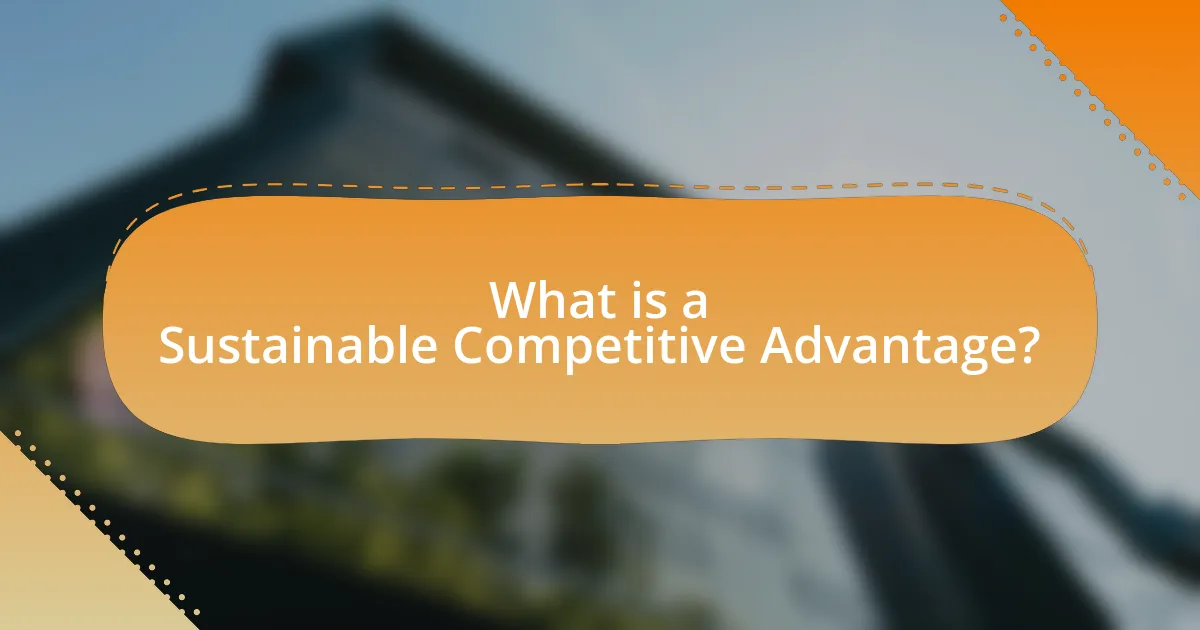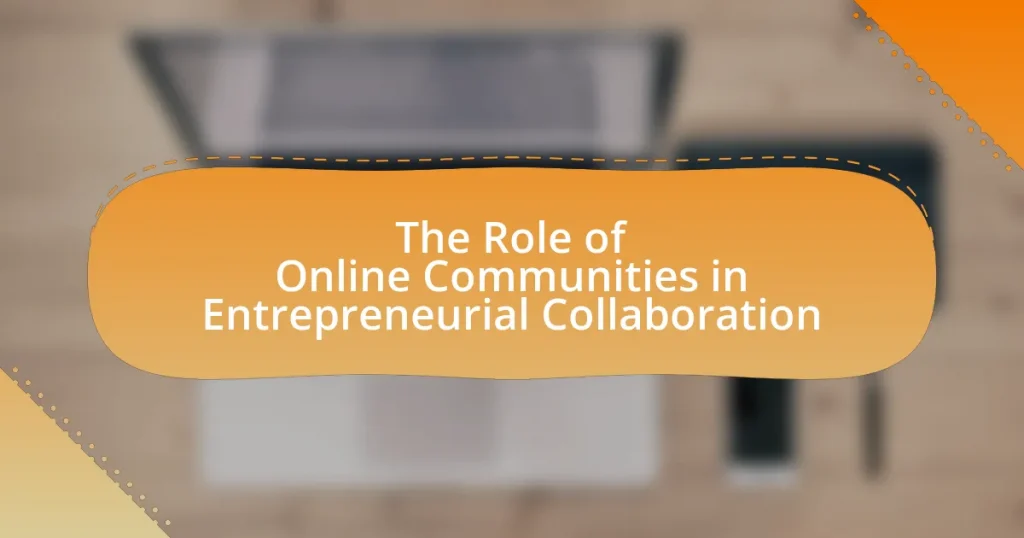A Sustainable Competitive Advantage is a unique edge that allows a company to outperform its competitors over the long term, often derived from factors such as superior technology, brand loyalty, or exclusive resources. This article explores the distinctions between sustainable and regular competitive advantages, highlighting key characteristics such as uniqueness, durability, and inimitability. It emphasizes the importance of innovation and market positioning in creating and maintaining a sustainable competitive advantage, while also addressing challenges entrepreneurs may face, such as market volatility and resource limitations. Additionally, the article outlines practical strategies for entrepreneurs to leverage innovation, enhance customer engagement, and implement continuous improvement practices to secure long-term success in a competitive landscape.

What is a Sustainable Competitive Advantage?
A sustainable competitive advantage is a unique edge that a company maintains over its competitors, allowing it to generate greater sales or margins. This advantage is often derived from factors such as superior technology, brand reputation, or unique resources that are difficult for competitors to replicate. For instance, companies like Apple leverage their strong brand loyalty and innovative product design to sustain their market position, making it challenging for competitors to erode their customer base.
How does a Sustainable Competitive Advantage differ from a regular competitive advantage?
A Sustainable Competitive Advantage is a long-term benefit that allows a company to maintain its market position over time, while a regular competitive advantage may be temporary and can be easily replicated by competitors. Sustainable Competitive Advantages often stem from unique resources, capabilities, or positioning that are difficult for others to imitate, such as proprietary technology, strong brand loyalty, or exclusive access to distribution channels. In contrast, regular competitive advantages can arise from factors like pricing strategies or promotional tactics that competitors can quickly adopt, diminishing their effectiveness. For example, companies like Apple have established a Sustainable Competitive Advantage through innovation and brand loyalty, which are not easily replicated, whereas a discount retailer may only have a regular competitive advantage based on pricing that can be matched by others.
What are the key characteristics of a Sustainable Competitive Advantage?
A Sustainable Competitive Advantage is characterized by its ability to provide long-term benefits that are difficult for competitors to replicate. Key characteristics include uniqueness, where the advantage is based on distinct resources or capabilities; durability, indicating that the advantage can withstand market changes over time; and inimitability, meaning that competitors cannot easily copy the advantage due to barriers such as proprietary technology or brand loyalty. Additionally, it must be relevant, ensuring that it aligns with market demands and consumer preferences. These characteristics are supported by the Resource-Based View theory, which emphasizes that firms can achieve superior performance through unique resources that are valuable, rare, and difficult to imitate.
Why is sustainability important in competitive advantage?
Sustainability is important in competitive advantage because it enhances brand reputation, reduces costs, and meets consumer demand for environmentally responsible practices. Companies that adopt sustainable practices often experience increased customer loyalty, as 66% of consumers are willing to pay more for sustainable brands, according to a Nielsen report. Furthermore, sustainable operations can lead to cost savings through energy efficiency and waste reduction, which improves overall profitability. By integrating sustainability into their business models, companies can differentiate themselves in the market, attract a growing segment of eco-conscious consumers, and ultimately secure a long-term competitive edge.
What role does innovation play in creating a Sustainable Competitive Advantage?
Innovation is crucial in creating a Sustainable Competitive Advantage as it enables businesses to differentiate their offerings and respond effectively to market changes. By introducing new products, services, or processes, companies can meet evolving customer needs and preferences, thereby enhancing customer loyalty and market share. For instance, firms like Apple have consistently leveraged innovation to maintain their competitive edge, evidenced by their ability to introduce groundbreaking technologies that redefine consumer expectations. This continuous innovation cycle not only attracts new customers but also retains existing ones, solidifying the company’s position in the market.
How can entrepreneurs leverage innovation for long-term success?
Entrepreneurs can leverage innovation for long-term success by continuously adapting their products and services to meet evolving market demands. This adaptability allows businesses to stay relevant and competitive, as evidenced by companies like Apple, which consistently invests in research and development to introduce groundbreaking technologies that reshape consumer expectations. Furthermore, a study by McKinsey & Company found that organizations that prioritize innovation are 2.5 times more likely to experience significant revenue growth compared to their less innovative counterparts. By fostering a culture of innovation, entrepreneurs can not only enhance customer satisfaction but also create unique value propositions that differentiate them in the marketplace, ultimately leading to sustained success.
What types of innovation are most effective for sustainability?
Technological innovation, process innovation, and business model innovation are the most effective types of innovation for sustainability. Technological innovation includes advancements in renewable energy, such as solar and wind power, which significantly reduce carbon emissions. Process innovation focuses on improving efficiency in resource use, exemplified by companies adopting circular economy principles to minimize waste. Business model innovation involves creating new ways to deliver value sustainably, such as subscription services that promote product longevity and reduce consumption. These innovations collectively contribute to environmental sustainability by decreasing resource depletion and promoting eco-friendly practices.
How can market positioning contribute to a Sustainable Competitive Advantage?
Market positioning contributes to a Sustainable Competitive Advantage by enabling a business to differentiate its offerings in a way that resonates with target customers. This differentiation can lead to increased brand loyalty, as consumers are more likely to choose a brand that aligns with their values and needs. For instance, companies like Apple have successfully positioned themselves as premium brands, allowing them to command higher prices and maintain customer loyalty, which is evidenced by their consistent market share and profitability. Additionally, effective market positioning can create barriers to entry for competitors, as it establishes a unique identity that is difficult to replicate. This strategic approach not only enhances customer perception but also solidifies a company’s long-term viability in the marketplace.
What strategies can entrepreneurs use for effective market positioning?
Entrepreneurs can use several strategies for effective market positioning, including differentiation, cost leadership, and niche marketing. Differentiation involves offering unique products or services that stand out from competitors, which can be supported by research indicating that 86% of consumers are willing to pay more for a better customer experience. Cost leadership focuses on becoming the lowest-cost producer in the industry, allowing entrepreneurs to attract price-sensitive customers; for instance, Walmart successfully employs this strategy to dominate the retail market. Niche marketing targets a specific segment of the market, enabling entrepreneurs to cater to specialized needs, as evidenced by companies like Tesla, which has carved out a significant share in the electric vehicle market by focusing on environmentally conscious consumers. These strategies collectively help entrepreneurs establish a strong market presence and competitive advantage.
How does understanding customer needs enhance market positioning?
Understanding customer needs enhances market positioning by enabling businesses to tailor their products and services to meet specific demands, thereby increasing customer satisfaction and loyalty. When companies analyze customer preferences and pain points, they can differentiate themselves from competitors by offering unique value propositions that resonate with their target audience. For instance, a study by McKinsey & Company found that companies that prioritize customer experience can achieve revenue growth of 5 to 10% above their market average. This alignment with customer expectations not only strengthens brand loyalty but also positions the company as a leader in its market segment, ultimately leading to a sustainable competitive advantage.
What are the challenges in establishing a Sustainable Competitive Advantage?
Establishing a Sustainable Competitive Advantage faces several challenges, including market volatility, technological changes, and resource limitations. Market volatility can lead to unpredictable shifts in consumer preferences, making it difficult for businesses to maintain a consistent edge. Technological changes require continuous adaptation and investment, as innovations can quickly render existing advantages obsolete. Resource limitations, such as financial constraints or talent shortages, hinder the ability to invest in necessary capabilities or strategies. According to a study by the Harvard Business Review, companies that fail to adapt to these challenges often see their competitive advantages diminish within a few years.
How can entrepreneurs overcome common obstacles?
Entrepreneurs can overcome common obstacles by leveraging strategic planning, building a strong support network, and continuously adapting to market changes. Strategic planning allows entrepreneurs to identify potential challenges and develop actionable solutions, which is supported by research indicating that businesses with a clear plan are 12% more likely to achieve their goals. A strong support network, including mentors and industry peers, provides valuable insights and resources, enhancing problem-solving capabilities. Additionally, continuous adaptation to market changes is crucial; studies show that companies that embrace innovation and flexibility can outperform their competitors by 30%. These strategies collectively empower entrepreneurs to navigate challenges effectively and maintain a sustainable competitive advantage.
What role does competition play in these challenges?
Competition plays a crucial role in the challenges entrepreneurs face when creating a sustainable competitive advantage. It drives innovation, as businesses must continuously improve their products and services to differentiate themselves from rivals. For instance, a study by the Harvard Business Review indicates that companies in highly competitive markets invest 30% more in research and development compared to those in less competitive environments. This heightened focus on innovation can lead to better customer satisfaction and loyalty, which are essential for long-term success. Additionally, competition can pressure entrepreneurs to optimize their operations and reduce costs, further enhancing their market position.
How can entrepreneurs measure the effectiveness of their Sustainable Competitive Advantage?
Entrepreneurs can measure the effectiveness of their Sustainable Competitive Advantage (SCA) by analyzing key performance indicators (KPIs) such as market share, customer loyalty, and profitability. These metrics provide quantifiable data that reflects how well the SCA differentiates the business from competitors. For instance, a study by the Harvard Business Review found that companies with a strong SCA experience 2.5 times higher profit margins than their competitors, indicating that effective SCAs lead to superior financial performance. Additionally, tracking customer retention rates can reveal the strength of brand loyalty, which is often a direct result of a well-established SCA.
What metrics should be used to evaluate sustainability in competitive advantage?
To evaluate sustainability in competitive advantage, key metrics include carbon footprint, resource efficiency, and social impact. Carbon footprint measures the total greenhouse gas emissions produced by a company, indicating its environmental impact and sustainability efforts. Resource efficiency assesses how effectively a company utilizes materials and energy, reflecting operational sustainability. Social impact metrics evaluate the effects of a company’s operations on communities and stakeholders, highlighting its commitment to social responsibility. These metrics provide a comprehensive view of a company’s sustainability performance, essential for maintaining a competitive edge in today’s market.
How can feedback loops improve the sustainability of competitive advantages?
Feedback loops enhance the sustainability of competitive advantages by facilitating continuous improvement and adaptation. These loops allow organizations to gather data on performance, customer preferences, and market trends, which can be analyzed to refine strategies and offerings. For instance, companies like Amazon utilize customer feedback to optimize their services, leading to increased customer loyalty and market share. This iterative process ensures that competitive advantages remain relevant and effective over time, as evidenced by research from Harvard Business Review, which highlights that organizations leveraging feedback mechanisms can outperform competitors by 30% in innovation and customer satisfaction metrics.
What are the best practices for maintaining a Sustainable Competitive Advantage?
To maintain a Sustainable Competitive Advantage, businesses should focus on continuous innovation, customer relationship management, and operational efficiency. Continuous innovation involves regularly updating products and services to meet changing market demands, as seen in companies like Apple, which consistently introduces new technology to stay ahead. Customer relationship management enhances loyalty and retention, exemplified by Amazon’s personalized shopping experiences that foster repeat business. Operational efficiency reduces costs and improves service delivery, demonstrated by Toyota’s lean manufacturing practices that optimize production processes. These best practices collectively ensure that a business remains competitive over time by adapting to market changes and meeting customer needs effectively.
How can continuous improvement strategies support sustainability?
Continuous improvement strategies support sustainability by systematically enhancing processes to reduce waste and resource consumption. These strategies, such as Lean and Six Sigma, focus on optimizing efficiency, which directly contributes to lower environmental impact. For instance, a study by the University of Cambridge found that companies implementing Lean practices reduced waste by up to 30%, demonstrating a clear link between continuous improvement and sustainability outcomes. By fostering a culture of ongoing assessment and adaptation, organizations can not only improve their operational performance but also align their practices with sustainable development goals, ultimately leading to a competitive advantage in the marketplace.
What role does customer engagement play in sustaining competitive advantages?
Customer engagement is crucial for sustaining competitive advantages as it fosters loyalty, enhances customer experience, and drives repeat business. Engaged customers are more likely to advocate for a brand, leading to increased word-of-mouth referrals and a stronger market presence. According to a study by Gallup, companies with high customer engagement levels outperform their competitors by 147% in earnings per share. This demonstrates that effective customer engagement strategies not only improve customer satisfaction but also significantly contribute to long-term financial success and market differentiation.
What practical steps can entrepreneurs take to create a Sustainable Competitive Advantage?
Entrepreneurs can create a Sustainable Competitive Advantage by focusing on innovation, customer relationships, and operational efficiency. Innovation allows businesses to develop unique products or services that meet specific market needs, which can differentiate them from competitors. For example, companies like Apple have maintained their advantage through continuous innovation in technology and design.
Building strong customer relationships enhances loyalty and repeat business, as seen in brands like Amazon, which prioritizes customer service and personalized experiences. This approach fosters trust and encourages customers to choose their brand over others.
Operational efficiency, achieved through streamlined processes and cost management, enables entrepreneurs to offer competitive pricing while maintaining quality. For instance, companies like Walmart leverage supply chain efficiencies to keep prices low, attracting a larger customer base.
By integrating these strategies, entrepreneurs can establish a Sustainable Competitive Advantage that is difficult for competitors to replicate.



